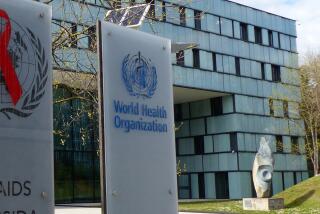AIDS Report Catches Researchers’ Criticism
Many researchers, calling for additional studies, are criticizing as premature a February study that concluded that people who live with AIDS victims are highly unlikely to catch the deadly disease through non-sexual contact.
In letters in the current issue of the New England Journal of Medicine, the researchers said the size of the sample in that study was too small, the exposure time too short and the blood tests used too unreliable to make any definitive conclusions.
Although stressing that the risk of becoming infected with the AIDS virus through non-sexual contact is probably small, the authors expressed concern that the February study might mislead people who have contact with AIDS patients into believing that there is no danger and thus fail to take adequate precautions.
“Household members and medical personnel who minister to patients with AIDS should not conclude that they can abandon prudent precautions in handling the body fluids of their patients, friends or family members,” wrote Dr. Clement McDonald and Michael Rogers of the Indiana University School of Medicine. “We are not arguing that the risks are in fact high, and we share the . . . hope that they are close to zero.”
USC’s James Mosley and Eva Operskalski wrote that longer periods of exposure may be more likely to cause transmission, saying: “We agree . . . that non-sexual household contacts are at minimum risk of infection, but think it is premature to conclude that there is no risk.”
In February, seven researchers from the Montefiore Medical Center in New York and one doctor from the federal Centers for Disease Control in Atlanta reported that, after studying 101 people who lived with AIDS victims for at least three months, there is “minimal or no risk” of catching the deadly disease, even by sharing toothbrushes, razors and toilets with AIDS carriers.
These researchers defend their findings, and said follow-up testing on the subjects since their research was published (also in the New England Journal of Medicine) failed to find any signs of infection.






